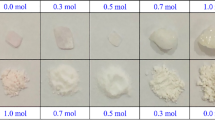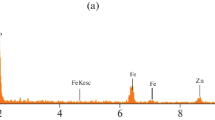Abstract
This work shows that the stereoactivity of the tin(II) lone pair, and its orientation in space when it is stereoactive, determines the dimensionality of crystal growth. In addition to one problematic case when good single crystals were available, often the absence of large enough crystals for single crystal diffraction, or their insufficient quality due to their low-dimensionality, has prompted us to find other methods to help solving crystal structures. A striking example of this is the case of α − PbSnF4. the structure of which could not be solved by X-ray single crystals or powder diffraction, due to the crystal shape. The two-dimensionality of the crystal structure of α − PbSnF4 creates an enormous amount of preferred orientation that cannot be eliminated by milling because it results in an order-disorder phase transition with formation of a nanocrytalline material. This report shows that the combination of X-ray powder diffraction and tin-119 Mössbauer spectroscopy was very successful in many cases. X-ray diffraction shows the crystal lattice and expected atomic positions, either from the normal methods of solving crystal structures, or by comparison with isostructural compounds, or by partial substitution on some sites in the case of solid solutions. However, Mössbauer spectroscopy, that is a very convenient method for determining the oxidation number of tin and its bonding method, shows that the suggested tin(II) positions obtained by diffraction methods can be erroneous in some cases, when the symmetry elements of the site would repeat the tin(II) stereoactive lone pair to make several lone pairs on the same tin atom. In this work, the combination of the two methods has been used to show that crystal structures previously determined from a single crystal (α − SnF2) or by the Rietveld method on hopelessly oriented samples (α − PbSnF4) over many years of difficult/hopeless efforts would have been greatly simplified and done much faster, had anyone thought of combining the two techniques. In particular, the crystallographers did not think of using the Mösbauer results. In addition, we have prepared stoichiometric compounds and also solid solutions, where the cubic symmetry of the unit-cell requires that tin(II) be in Wyckoff sites that would repeat the tin(II) lone pair many times on the same tin(II) atom. In these cases too, the combination of the two methods made it possible to propose a highly reasonable model of the crystal structure.
Similar content being viewed by others
References
McDonald, R.C., Ho-Kuen Hau, H., Eriks, K.: Inorg. Chem. 15, 762 (1976)
Dénès, G., Pannetier, J., Lucas, J., Le Marouille, J.Y.: J. Sol. State Chem. 30, 335 (1979)
Birchall, T., Dénès, G., Ruebenbauer, K., Pannetier, J.: Hyperf. Interact. 29, 1331 (1986)
Dénès, G.: J. Solid State Chem. 74, 343 (1988)
Pannetier, J., Dénès, G., Lucas, J.: Mater. Res. Bull. 14, 627 (1979)
Dénès, G., Madamba, M.C.: Mater. Struct. Chem. Bio. Phys. Technol. 3, 227 (1996)
Merazig, H., Setifi, F., Setifi, Z., Bird, P.H., Dénès, G., Tam, K.: Acta Cryst. E. 61, i120 (2005)
P. A. M. Dirac, Principles of Quantum Mechanics. International Series of Monographs on Physics (4th ed.). Oxford University Press (1982), 255
Galy, J., Meunier, G., Andersson, S., Aström, A.: J. Solid State Chem. 13, 142 (1975)
Gillespie, R.J., Nyholm, R.S.: Quart. Rev. Chem. Soc. 11, 339 (1957)
Brown, I.D.: J. Solid State Chem. 11, 214 (1974)
Dénès, G.: J. Solid State Chem. 77, 54 (1988)
Dénès, G., Madamba, M.C.: Mater. Struct. 3, 227 (1996)
G. Dénès and K. Ruebenbauer, GMFP5, an extension of GMFP [15] to five hyperfine sites, unpublished results
Ruebenbauer, K., Birchall, T.: Hyperf. Interact. 7, 125 (1979)
Donaldson, J.D., Senior, B.J.: J. Chem. Soc. A. 2358 (1969)
Acker, E., Haussuhl, S., Recker, K.: J. Crystal Growth. 13/14, 467 (1972)
Bergerhoff, G.: Acta Crystallogr. 15, 509 (1962)
G. Dénès, unpublished results
Donaldson, J.D., Oteng, R., Senior, B.J.: J. Chem. Soc., Chez. Comm. 618 (1965)
Dénès, G., Madamba, M.C., Muntasar, A.: AIP Conf. Proc. 1781(2016), 020007–1–020007-17 (2016). https://doi.org/10.1063/1.4966003
Greenwood, N.N., Gibb, T.C.: Mössbauer Spectroscopy, pp. 66–72. Chapman and Hall, London (1971)
Birchall, T., Dénès, G., Ruebenbauer, K., Pannetier, J.: Hyp. Interact. 29, 1327 (1986)
Birchall, T., Dénès, G., Ruebenbauer, K., Pannetier, J.: Hyp. Interact. 30, 167 (1986)
Greenwood, N.N., Gibb, T.C.: Mössbauer spectroscopy, p. 375. Chapman and Hall, London (1971)
Bergerhoff, G., Goost, L.: Acta Crystallogr. B. 30, 1362 (1974)
Pfanes, H.D., Gonser, U.: Appl. Phys. 1, 93 (1973)
Dénès, G., Tam, K.: J. Can. Ceram. Soc. 57, 39 (1988)
Donaldson, J.D., Senior, B.J.: J. Chem. Soc. A. 1821 (1967)
Dénès, G., Pannetier, J., Lucas, J.: C. R. Acad. Sc. Paris. 280C, 831 (1975)
Durand, M., Pannetier, J., Dénès, G.: J. Physique (Paris). 41, 831 (1980)
Dénès, G., Yu, Y.H., Tyliszczak, T., Hitchcock, A.P.: J. Solid State Chem. 104, 239 (1993)
G. Dénès, Proc. 2nd Mössbauer Conference, C. I Wynter and E. E. Alp (ed.), W. C. Brown Publishers (1994), 109
Dénès, G., Muntasar, A., Zhu, Z.: Hyperf. Interac. C1, 468 (1996)
Dénès, G., Madamba, M.C., Muntasar, A., Peroutka, A., Zhu, Z.: Mater. Res. Soc. Symp. Proc. 548, 491 (1999)
Scherrer, P.: Göttinger Nachrichten Gesell. 2, 98 (1918)
B.D. Cullity & S.R. Stock, Elements of X-ray Diffraction, 3rd ed., Prentice Hall inc. (2001), pp. 167–171
B.E. Warren, X-ray Diffraction, Addison-Wesley Publishing Co. (1969), pp. 251–254
Wyckoff, R.W.G.: Crystal structures. Interscience, New York. I, 134–136 (1965)
Moore, W., Pauling, L.: J. Am. Chem. Soc. 63, 1392 (1941)
Pannetier, J., Dénès, G.: Acta Crystallogr. B. 36, 2763 (1980)
Birchall, T., Dénès, G., Ruebenbauer, K., Pannetier, J.: J. Chem. Soc. Dalton. 1831 (1981)
Birchall, T., Dénès, G., Ruebenbauer, K., Pannetier, J.: J. Chem. Soc. Dalton. 2296 (1981)
Goldanskii, V.I., Marakov, E.F., Stukan, R.A., Samakosova, T.N., Trakhtanov, V.A., Khrapov, V.V.: Proc. Acad. Sci. USSR. 156, 474 (1964)
Dénès, G.: Mater. Res. Bull. 15, 807 (1980)
Weast, R.C., Astle, M.J.: CRC handbook of chemistry and physics, 61st Edition, p. B-159. CRC Press, Boca Raton (1980–1981)
Acknowledgements
This work is dedicated to the memory of Prof. Krzysztof Ruebenbauer, Pedagogical University, Krakow, Poland, who passed away on April 23, 2018. He contributed so much to our understanding of the Mössbauer effect in divalent tin materials.
This work was made possible by the support of Concordia University and the Natural Science and Engineering Research Council of Canada. Grateful thanks are also due to the Procter and Gamble Co. (Mason, Ohio) for supporting our Mössbauer laboratory.
Author information
Authors and Affiliations
Corresponding author
Additional information
Publisher’s note
Springer Nature remains neutral with regard to jurisdictional claims in published maps and institutional affiliations.
This article is part of the Topical Collection on Proceedings of the 5th Mediterranean Conference on the Applications of the Mösbauer Effect (MECAME 2019) and 41st Workshop of the French-speaking Group of Mösbauer Spectroscopy (GFSM 2019), Montpellier, France, 19-23 May 2019
Edited by Pierre-Emmanuel Lippens, Yann Garcia, Moulay-Tahar Sougrati and Mira Ristic (†)
Rights and permissions
About this article
Cite this article
Dénès, G., Madamba, M.C., Parris, J.M. et al. Joy and frustrations of growing crystals of divalent tin compounds: getting only powders or low-dimensionalcrystals. Hyperfine Interact 241, 23 (2020). https://doi.org/10.1007/s10751-019-1657-9
Published:
DOI: https://doi.org/10.1007/s10751-019-1657-9




